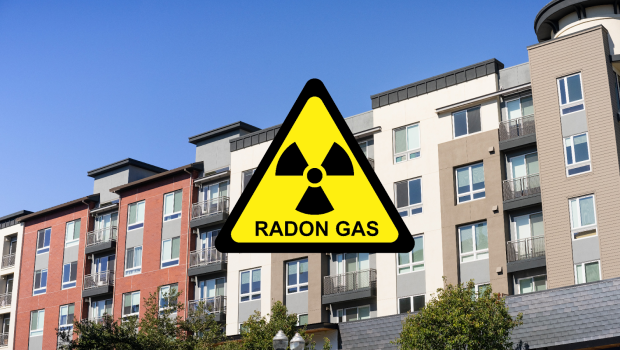Breathing Safe Together: Radon Awareness in Multi-Family Housing
Radon is a naturally occurring radioactive gas that is produced when uranium or radium in the soil decays. Odorless, tasteless, invisible, and impossible to detect without proper equipment, radon has been deemed a “silent killer” as it travels upward through the earth and into the places people live and work.
“Homeowners are not the only people who need to be aware of radon gas,” says Insoo Park, founder and CEO of Ecosense. “If you are living in a multi-family housing unit, you also need to know how radon can seriously affect your health. Don’t wait for your landlord to take the lead — educate yourself and protect your loved ones from this silent threat.”
The health risk of radon gas in multi-family housing
Over one-third of housing units in the US are rentals, most of which are apartments located below the third floor of a building. Radon poses a significant health concern in multi-family buildings, as it is commonly found in ground-level apartments, condos, and townhomes where it can accumulate.
Over time, water freezes and thaws, creating cracks in walls, floors, and foundations. When radon seeps into apartments and condominiums through these cracks or up through drains, it can rise to dangerous levels, exposing residents to potentially deadly health risks.
The primary health problem associated with radon exposure is lung cancer, with the Environmental Protection Agency (EPA) reporting exposure to radon gas as the second leading cause of lung cancer in the United States after smoking. According to the EPA’s research, radon exposure is responsible for at least 21,000 lung cancer deaths in the US each year.
Testing radon levels in multi-family housing
“The only way to discover whether residents of multi-family housing are exposed to high levels of radon is to test each and every ground-level unit,” says Parks. “In the past, this was a job for professionals, but today’s residents can perform testing themselves with affordable and accurate long-term radon monitoring devices.”
As Park explains, tenants can ask their building owners or managers if the building has been tested and ask them to see a copy of the test results. Because radon gas is drawn upward from the ground, higher concentrations are more likely to be found below the third floor of buildings. Radon levels fluctuate continuously, varying by season, and changing even within a single day. Therefore, testing should not be limited to a one-time or short-term event. Keeping in mind that radon entry is influenced by other various factors such as temperature, humidity, barometric pressure, and human behaviors, it makes it inevitable for radon to fluctuate
“Long-term testing is far more helpful and accurate when it comes to determining an apartment’s year-round average radon level,” Park explains, adding that the most effective form of radon monitoring is continuous. “This is why ongoing testing for radon levels is essential in multi-family housing units.”
The EPA recommends testing every ground-contact apartment including those over crawl spaces, unoccupied basements, and parking garages. They also recommend testing at least 10% of the units on the second and third floors and at least one apartment on every floor above the third floor. This is because radon can be drawn upward through elevator shafts, air ducts, and other avenues where indoor pressure is lower than that of soil air below the building…
Installing mitigation systems in apartments and condominiums
Almost every state in the US has legislation in place that requires landlords and property managers to keep rental properties safe and habitable for residents. If tenants discover high radon levels, Park notes that they should immediately alert their building’s owners in writing and provide them with a copy of their test results to open a conversation about steps to address and fix the issue. Building owners will need to confirm these tests, and tenants have the right to ask for the latest test reports.
If testing reveals an apartment or condominium has dangerously high levels of radon, the building owner must take action to reduce the risk of exposure to residents. Sometimes, high radon levels can be reduced by making necessary repairs to the building’s mechanical systems, but building owners can also install radon mitigation systems to redirect radon gas from the interior.
“Many of these systems for residential buildings are relatively inexpensive and easy to install,” says Park, “but the most appropriate mitigation system will vary based on the type of building, its age, as well as the materials used in its construction. Building owners should work with radon mitigation specialists to determine the most effective system for their specific situation.”
Educating residents of multi-family housing about the risk associated with radon exposure
Residents of apartment multi-family housing units should consider sharing their radon information and test results with other tenants who may also want to test their own units and join the conversation. “Remember that just because your radon levels are low doesn’t mean it’s the same for your neighbors,” says Park. “Radon can be low in one area and high in other areas of the building, so sharing this information with neighbors can benefit them by helping them stay aware of the danger.”
Owners of multi-family housing units should take the lead and educate their tenants about testing for radon levels and actions to improve air quality quickly, such as opening doors and windows. By the same token, tenants have a responsibility to educate their landlords and other residents about the risks of radon exposure and the benefits of regular testing. Educational materials, such as brochures and posters, can be distributed to promote radon awareness. Additionally, there are various radon-related websites available on the internet that provide accurate and helpful information for individuals seeking to learn more about radon and its potential risks.
To raise awareness even further, concerned citizens can encourage state and national leaders to incorporate radon testing requirements into building codes for multi-family housing units. Advocating for the adoption of these requirements and regulations will ensure that new multi-family housing units are designed to minimize radon entry.


































